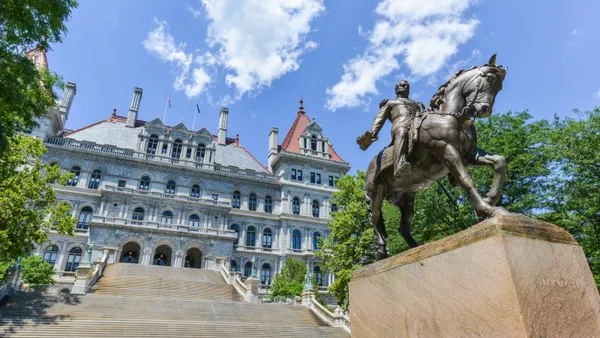Dive Brief:
-
British Columbia changed its building codes in March to allow wood buildings as tall as 12 stories — double that of the former code — but there are plans underway for even taller wood structures in the province and elsewhere, The Guardian reported. Changes to Canada's national building code, according to British Columbia Premier John Horgan, are scheduled to go into effect next year.
-
British Columbia, where the wood industry is thriving, also paved the way for those cities wanting to pursue tall wood buildings by providing exceptions to the code for the 18-story mass timber Brock Commons residence hall at the University of British Columbia in Vancouver and the planned 40-story Canada Earth Tower.
-
Tall wood advocates told The Guardian that British Columbia's willingness to challenge building codes and build taller wood structures has led to changes in codes not only across Canada but in the U.S. and Japan, where Tokyo-based architects are planning a 70-story cross-laminated timber (CLT) high-rise.
Dive Insight:
Another advantage of mass timber construction, The Guardian reported, is that the material comes from younger trees, which protects the old-growth forests that have developed over generations.
In U.S., Portland, Oregon — with the support of statewide changes — and Minneapolis and Milwaukee have taken the lead in granting building code exceptions or changing their regulations altogether to allow tall mass timber buildings, and large cities like Chicago and New York City have also made moves toward allowing tall wood construction.
Meanwhile, M.A. Mortenson Co. has teamed up with Urban Development Partners to build Arizona's first CLT Class A office building in Tempe, Arizona. At five stories and 185,000 square feet, the building, which will also include some concrete and steel, will feature 15-foot exposed wood ceilings with glulam (glue-laminated timber) wood beams and columns.
And in downtown Des Moines, Iowa, the first dowel-laminated timber (DLT) building in the U.S. opened for business this year.
However, it is the International Code Council's recent introduction of tall wood building codes that are likely to have the biggest impact across the U.S., as all 50 states incorporate some element of the council's I-Codes into their own building regulations. Beginning with the ICC's 2021 edition of the International Building Code, 14 new codes will go into effect, allowing the construction of tall wood buildings up to 18 stories. The code changes also introduce three new types of construction — Type IV-A, Type IV-B and Type IV, governing the construction of tall wood buildings from 85 feet to 270 feet.












